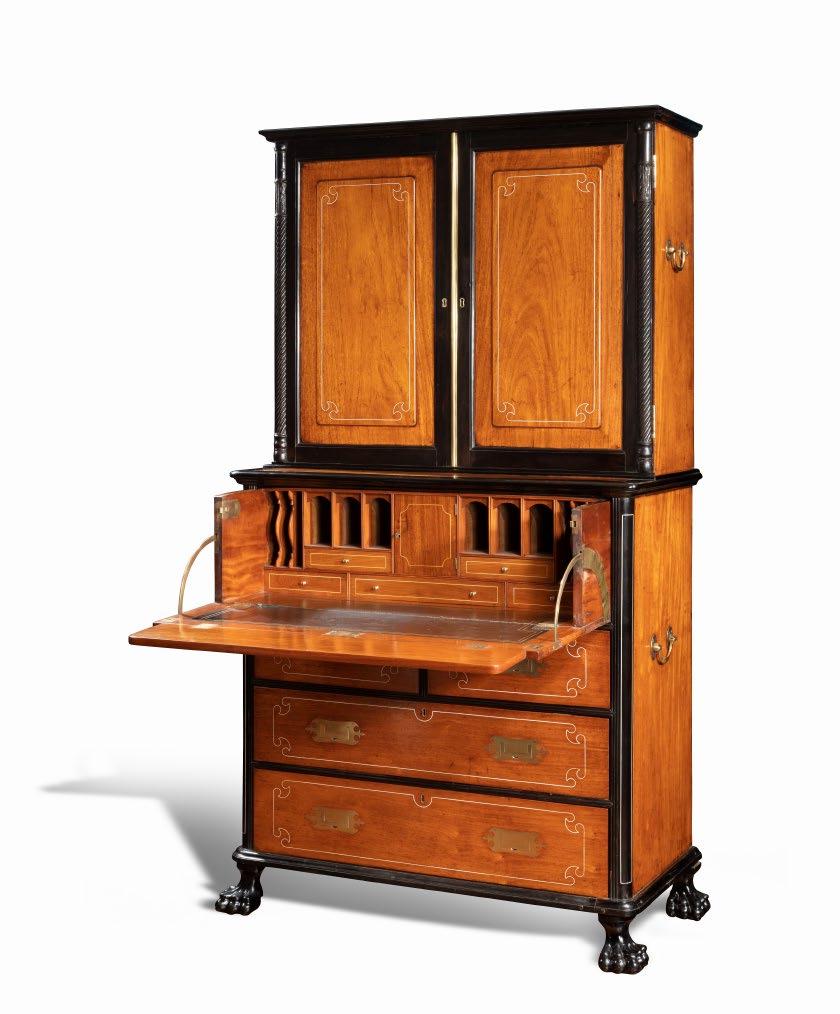
4 minute read
An Anglo-Chinese camphor and ebony campaign secretaire bookcase
An Anglo-Chinese camphor and ebony campaign secretaire bookcase
Height: 73in (185.5cm) Width: 38½in (98cm) Depth: 19½in (49.5cm)
Advertisement
This bookcase is of rectangular form in two sections, each with carrying handles. The upper section has cupboard doors which open to reveal two adjustable shelves. The lower section has a secretaire drawer fitted with letter racks, pigeon holes, small drawers and an unfolding extension to the fall, all above two short and two long drawers. The whole piece is raised on detachable lion’s paw feet and decorated throughout with solid ebony mouldings, bone stringing and applied with superb quality cut brass flush handles. Chinese, circa 1820.
46 Gillows of Lancaster and London: a truly global enterprise.
The next few pages focus on our collection of furniture made by Gillows of Lancaster and London. This firm was arguably the furniture manufacturing company that took maximum advantage of the trade routes kept secure by the Royal Navy, both in times of conflict and peace. The firm was founded in 1728 by Robert Gillow (1704-1772) who was not only a joiner and cabinet maker, but a jack of all trades; architect, house-carpenter and contractor, funeral director and West Indies merchant. He laid the foundations of a successful firm which retained the Gillows family name for over two hundred and fifty years, and was the only firm of its kind to maintain branches both in the provinces and the capital city. The firm is unique in two other respects: firstly, a high proportion of the Gillow Archives has survived, including estimate sketch books, letter books and other business ledgers spanning 1730-1930. Secondly, the Gillows stamp was used on some pieces from around 1790, creating a physical inventory of the range and quality of their output. In 1757 Robert Gillow’s eldest son Richard Gillow (17341811) joined his father as an equal partner. He further developed the firm by favouring new London designs, searching out foreign markets, widening apprenticeships and using only the best timber and other materials. Sourcing fine quality woods was essential to sustain the firm’s reputation for ‘good workmanship, good wood and good value.’ To ensure the supply of best quality timber the Gillows firm engaged in international trade from the outset. The varieties and countries of origin were incredible. A ‘work box of various woods made for Miss Giffard of Nerquis Hall’ in 1808 by ‘Robert Gillow and Brothers, together with a numbered key and pencil sketch, identified 72 ‘Specimens of Curious wood (English and Foreign)’ used in the Gillow workshops. Many woods, unrecognised today, were labelled simply by place of origin; Angola, Botany Bay, Brazil, Gambia, Guiana, Kangaroo, Mexico, Manilla, Nova Scotia, Parama, Palmaletta, St John (Antigua) and Savacue. Other more familiar woods, like ebony (Mauritius, Ceylon, Indian Islands, South Africa), walnut (North America, Italy, Spain) and mahogany (Honduras, Havana, Hispaniola, Jamaica) could be sourced in many countries resulting in different colours and textures. The West Indies also provided satinwood, purple wood and cedar; while North America supplied a different cedar, maples, white and red oak, white pine and hickory. Southern America, especially Brazil, along with the Canary Islands and Azores supplied rosewood, kingwood, canary wood and orange wood. Heading east and north merchants bought oak and deal from Riga and Danzig, elm from the Netherlands, Albuera wood (Goncalo Alves) from Spain and greywood (Harewood) from France. Even further afield they found calamander and coromandel in Ceylon and tulip wood in the East Indies. Gillows was the first company to use Botany Bay wood (also called Casuarina, Beefwood or She-Oak) listed as No. 20 on the work box.
However, buying and importing raw materials was only half the story. The Gillow family worked tirelessly to export finished furniture and commissions across the globe. As early as the 1730s Robert Gillow sold his goods to sea captains and merchants who exported them to foreign shores. In 1757 Richard Gillow was promoting pieces in walnut and mahogany in St. Petersburg and trade with the Canary Islands, in exchange for wine, was established in 1769. At the same time a large consignment sent to North America was recorded in 1750 and Gillows furnished a house for Mr Thomas English in Boston in 1785. When wars on and around the Atlantic disrupted trade to the west the firm turned to Northern Europe, Turkey, the East Indies, Shanghai, Australia and New Zealand – one Thomas Archer emigrated to Tasmania in 1839 with a complete household of furniture commissioned from the London shop. Richard’s sons ran the firm until 1814 when it was taken over by Redmayne, Whiteside, and Ferguson, who continued to use the Gillow name. Gillows furniture is mentioned by Jane Austen, Thackeray and in one of Gilbert and Sullivan's comic operas. It became a byword for high quality furniture. In the 20th century Gillows merged with Warings of Liverpool (1903) and with Maple & Co. (1980) to become Maple, Waring and Gillow. We are most grateful to Susan E. Stuart for her extensive work Gillows of Lancaster and London 1730-1840, Volumes I & II, Antique Collectors’ Club, Woodbridge, 2008, for the information contained in the paragraphs above and the footnotes for the following items of Gillows furniture.










